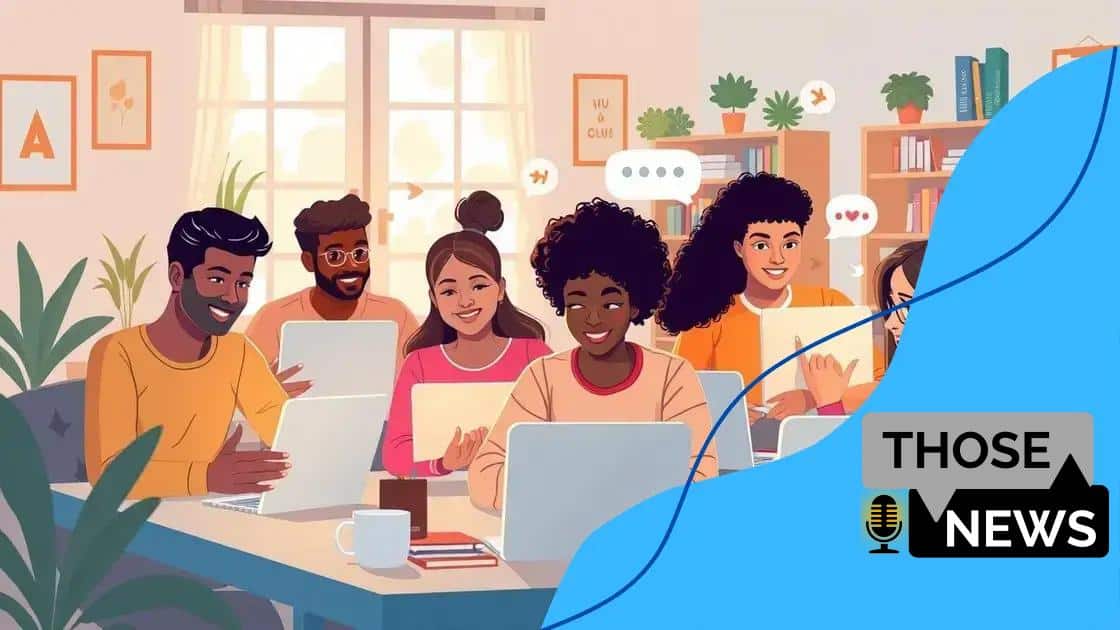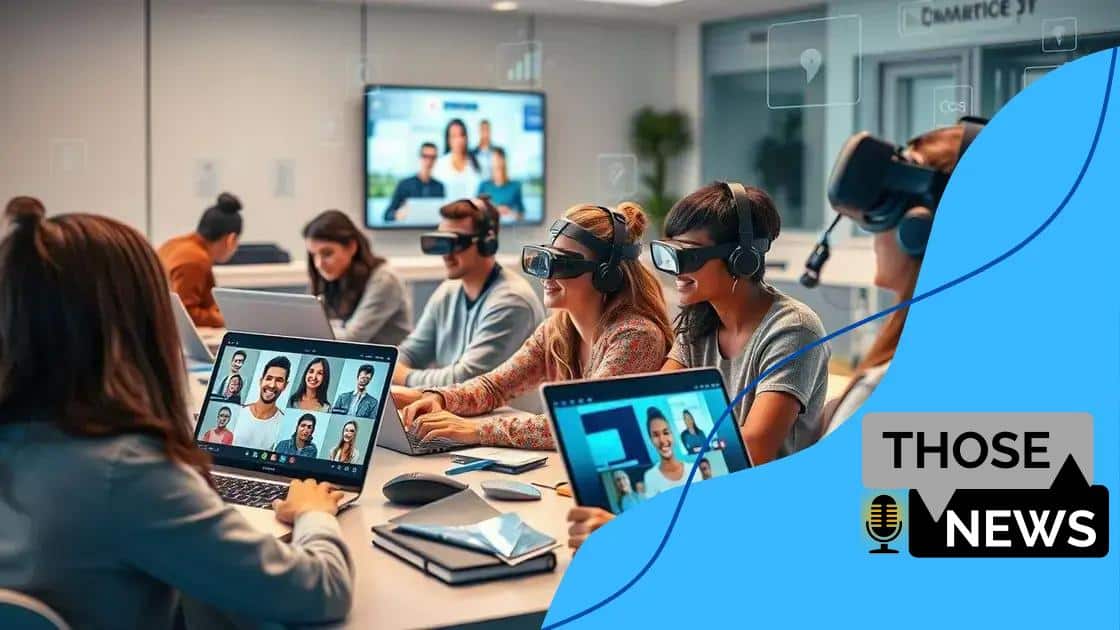The impact of virtual classrooms on student collaboration

The impact of virtual classrooms on student collaboration is significant, as these digital environments enhance communication, foster teamwork across diverse locations, and utilize advanced technologies to create engaging learning experiences.
The impact of virtual classrooms on student collaboration is becoming increasingly relevant as education evolves. Have you noticed how students engage differently in online settings? Let’s dive into the nuances of this transformation.
Understanding virtual classrooms
Understanding virtual classrooms is essential in today’s education landscape. These digital environments provide unique opportunities for learners. They allow students from different areas to come together and participate in learning activities seamlessly.
The Concept of Virtual Classrooms
A virtual classroom is a digital space where educators and students interact, regardless of their physical locations. This setup relies heavily on technology to create an engaging learning environment. By using various tools like video conferencing, discussion forums, and shared resources, students can collaborate effectively.
Key Features of Virtual Classrooms
Some important features include:
- Real-time interaction: Students can communicate instantly with teachers and peers.
- Access to resources: Educational materials are available at any time, aiding students in their studies.
- Flexible learning: Learners can join classes from anywhere, fitting education into their schedules.
In essence, virtual classrooms break down barriers present in traditional education. Students interact through chat functions or video calls, encouraging a sense of community. As they collaborate on projects or assignments, these spaces foster teamwork in ways that were previously challenging.
Furthermore, the customization of learning experiences supports individual needs. Educators can tailor content to suit various learning styles, making education more effective. This adaptability encourages motivation among students, leading to enhanced participation.
As we delve deeper into virtual classrooms, we discover their impact on student collaboration. Students learn to rely on each other more, leveraging technology to solve problems collectively. The dynamic nature of these environments promotes engagement and creativity, essential factors in today’s educational success.
Benefits of remote collaboration
Engaging in remote collaboration offers numerous advantages for students and educators alike. This modern approach to teamwork enables students to connect with peers from diverse backgrounds. It also promotes a richer learning experience, pushing them to think critically and creatively.
Enhanced Communication Skills
Collaboration in a virtual setting often requires clearer communication. Students must express their ideas effectively through chat or video calls. This practice helps them develop essential skills that benefit them beyond the classroom.
Access to a Wider Network
When students collaborate remotely, they can reach peers across the globe. This exposure broadens perspectives and introduces them to different cultures and ideas. It is an invaluable opportunity for personal and academic growth.
- Networking opportunities: Students can connect with industry professionals.
- Collaborative projects: Working together on assignments fosters team spirit.
- Diverse insights: Sharing different viewpoints enriches discussions.
Moreover, remote collaboration allows students to learn at their own pace. They can take time to think through challenges without the pressure of in-person interactions. This flexibility encourages deeper engagement with the material. As students collaborate online, they also become more adept at using technology.
These skills will serve them well in their future careers. Companies value employees who can work together effectively, regardless of location. By embracing remote collaboration, students not only succeed academically but also prepare themselves for the job market.
Technologies enhancing virtual interaction

Technologies are revolutionizing how students engage in virtual interaction. By utilizing various tools, they can collaborate effectively and share knowledge in real-time. The advancements in technology have paved the way for interactive and immersive learning experiences that keep students engaged.
Video Conferencing Tools
Video conferencing platforms like Zoom and Microsoft Teams allow students to participate in live discussions. These tools enable face-to-face interaction, which is crucial for building connections. They facilitate group activities, ensuring everyone can contribute regardless of their location.
Collaborative Software
Software solutions such as Google Workspace and Microsoft 365 offer shared documents and spreadsheets. This collaborative environment encourages teamwork as multiple users can edit and contribute simultaneously. It promotes a sense of ownership among students as they work together on projects.
- Cloud storage: Students can access their files anytime, anywhere.
- Task management: Tools help organize assignments and deadlines.
- Real-time feedback: Teachers can provide immediate suggestions, enhancing learning.
Additionally, technologies like gamification tools create an engaging atmosphere. By incorporating elements of gaming into learning, students are often more motivated to participate. They enjoy friendly competition and are eager to achieve goals set within these interactive frameworks.
Another important aspect is the use of virtual reality (VR) and augmented reality (AR). These technologies provide immersive experiences, making lessons more engaging. Students can explore different environments and scenarios that would not be possible in a traditional setting. This hands-on approach fosters deeper understanding and retention of information.
Challenges faced by students
Students face several challenges in virtual classrooms. While technology provides many benefits, it also brings unique difficulties. Understanding these challenges is essential for improving the online learning experience.
Technical Issues
One major challenge is dealing with technical problems. Slow internet connections can disrupt classes. Students may miss important information or fall behind when their devices malfunction. These issues make it hard to stay focused and engaged.
Lack of Social Interaction
Another challenge is the lack of face-to-face interaction. Students often miss the personal connections made in traditional classrooms. The absence of casual conversations can lead to feelings of isolation. This can affect their motivation and overall mental health.
- Reduced collaboration: Limited opportunities for teamwork can hinder peer learning.
- Feeling disconnected: Students might feel less involved in the learning community.
- Social anxiety: Some students may struggle with participating in virtual discussions.
Additionally, the self-discipline required for online learning can be overwhelming. With fewer external reminders, students must manage their time effectively. This can lead to procrastination or burnout as they juggle multiple responsibilities.
Finally, the different learning styles of students can be challenging to address in a virtual format. Some learners thrive in interactive environments, while others need more direct instruction. Meeting these varied needs requires careful planning and adaptability from educators.
Future of teamwork in education
The future of teamwork in education looks promising as technology continues to evolve. Innovations are reshaping how students collaborate and learn together. With the rise of online learning platforms and digital tools, the landscape of education is transforming.
Increased Collaboration Tools
New tools are enabling students to work together more effectively. Platforms like Slack and Trello allow for better project management and communication. These tools facilitate collaboration, making it easier for teams to stay organized and connected.
Global Classrooms
As technology connects students from around the world, global classrooms are becoming a reality. This exposure introduces learners to diverse cultures and ideas. They can collaborate with peers from different countries, enhancing their learning experiences.
- Broader perspectives: Working with international students helps develop critical thinking.
- Real-world skills: Students learn to work with people from various backgrounds.
- Language development: Collaborating internationally provides language practice.
Moreover, the use of artificial intelligence in education will further enhance teamwork. AI can analyze student interactions and suggest tailored resources. This personalization helps teams work more effectively together, focusing on their strengths and weaknesses.
Furthermore, gamification will likely play a significant role in future educational teamwork. By incorporating game elements into group projects, educators can create engaging experiences. This approach motivates students while fostering a collaborative spirit. The more engaged students are, the more they will want to participate in team activities.
FAQ – Frequently Asked Questions about the impact of virtual classrooms on student collaboration
What are the main benefits of virtual classrooms for student collaboration?
Virtual classrooms enhance communication, allowing students to work together effectively from different locations and fostering a sense of community.
How do technologies improve teamwork in online learning environments?
Technologies like video conferencing, collaborative software, and gamification tools help facilitate engagement and effective interaction among students.
What challenges do students face in virtual collaboration?
Students may experience technical issues, feelings of isolation, or difficulty managing their time effectively while learning online.
How can teachers support collaboration in virtual classrooms?
Teachers can provide clear guidelines, use interactive tools, and create group projects that encourage teamwork and communication among students.





